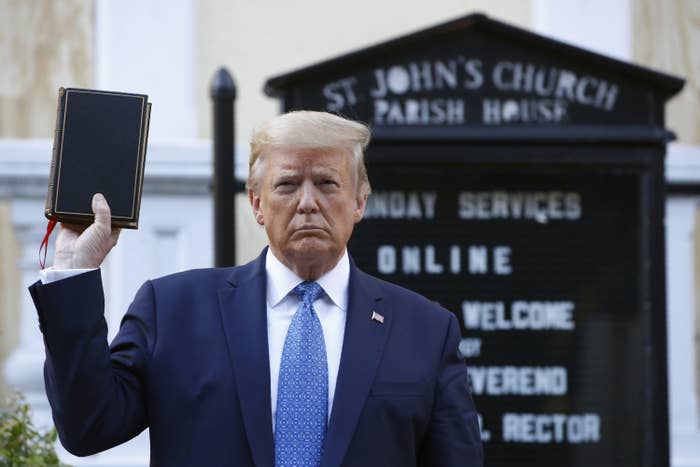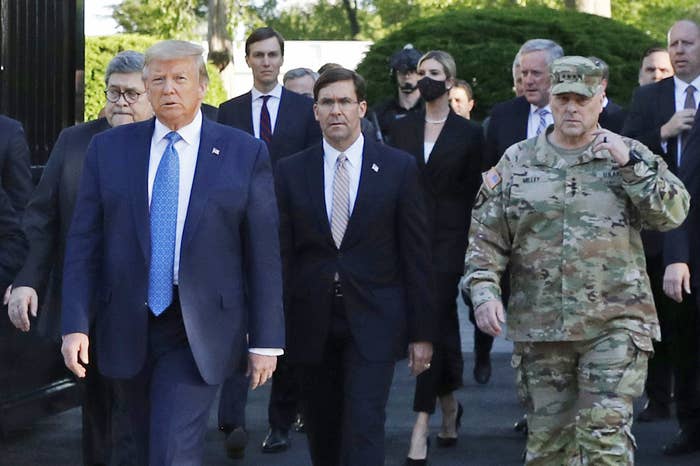
Federal police officers violently cleared a peaceful protest from Lafayette Square in June 2020 to install fencing, a federal investigation found, contradicting eyewitness accounts that demonstrators were aggressively dispersed so that former president Donald Trump could take photos outside a church.
According to a report released Wednesday, the Department of Interior's inspector general, the US Park Police (USPP), and the Secret Service, as well as six other law enforcement agencies, had planned to clear the park for a contractor to install anti-scale fencing that evening before they were aware of Trump's intent to walk across the park for a now-infamous photo op.
The operation to disperse the crowd was set on the morning of June 1, the report states. Investigators spoke with officials with the USPP and the National Park Service — which runs the park — as well as several other law enforcement officers who provided more information about the planned activities.
The violent dispersal of protesters took place just as Trump was getting ready to walk to a church following days of racial justice demonstrations across the country. He was accompanied by top military leaders and then–attorney general Bill Barr.
BuzzFeed News reporter Kadia Goba, then a part of the White House press corps, reported hearing "loud booming sounds, the kind you might hear during wartime," during Trump's brief remarks at the White House before he walked to St. John's Episcopal Church.
Officers could also be seen firing tear gas into the crowd — a fact that multiple officials, including Barr, initially denied — and violently arresting protesters. The incident stunned a nation already outraged by police brutality against protesters and the killing of George Floyd.
The report on Wednesday included the timeline of the USPP's plans and the installation of the fence, as well as Trump's walk to the church. Police pushed protesters out of the park from 6:23 to 6:50 p.m. Trump's walk began at 7:01 p.m. Work on installing the fence started at 7:30 p.m. and lasted for five hours.
A video reconstruction of the events by the Washington Post shows Trump beginning his speech at the White House at 6:44 p.m. Meanwhile, officers are seen detaining protesters and throwing chemical grenades at crowds.
At 7:08 p.m., Trump holds up a Bible outside the church for a three-minute photo op before returning to the White House, according to the Washington Post.
Although investigators said there is no evidence that Barr influenced the USPP's timeline, the report raises questions about his involvement in the operation. Investigators did not interview Barr, who has denied issuing the order to disperse protesters, contrary to what a Justice Department official and former White House press secretary Kayleigh McEnany claimed.
According to the report, Barr arrived at Lafayette Square at 6:10 p.m., and a USPP official is seen in news video having an exchange with him. The official said he advised Barr to move away from the crowd, and the attorney general responded by asking, "Are these people still going to be here when POTUS [President of the United States] comes out?"
The USPP official told investigators he did not know before his interaction with Barr that Trump would be heading to Lafayette Square.
"I’m not involved in giving tactical commands like that," Barr told the Associated Press days after the incident. "I was frustrated and I was also worried that as the crowd grew, it was going to be harder and harder to do. So my attitude was get it done, but I didn’t say, 'Go do it.'"

The report detailed the USPP's plan to clear the park but did not address law enforcement's violent tactics that injured several protesters "as those are the subject of separate inquiries as well as ongoing lawsuits," it states.
Mark Lee Greenblatt, the Interior Department's inspector general, acknowledged that the department has no oversight power with the other law enforcement agencies that the USPP worked with.
The report also found that there was poor communication and coordination between USPP and its law enforcement partners during the operation, which "may have contributed to confusion during the operation and the use of tactics that appeared inconsistent with the incident commander’s operational plan."
The June 1 incident was a defining moment in Trump's presidency, even amid a term in office that was besieged by scandal and controversy.
In a statement about the Interior Department's findings Wednesday, the former president praised the inspector general for "exonerating" him, calling the report "highly detailed and professionally written."
